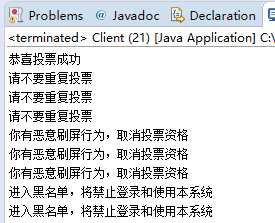行为模式-状态模式
Posted liunianfeiyu
tags:
篇首语:本文由小常识网(cha138.com)小编为大家整理,主要介绍了行为模式-状态模式相关的知识,希望对你有一定的参考价值。
行为型模式又可以分成以下四类:第一类:通过父类与子类的关系进行实现。第二类:两个类之间。第三类:类的状态。第四类:通过中间类
状态模式属于第三类,类的状态
当状态改变时,行为也会发生相应变化
下面以投票为例
package behavior.pattern.status.status.example;
public interface VoteState {
/**
* 处理状态对应的行为
* @param user 投票人
* @param voteItem 投票项
* @param voteManager 投票上下文,用来在实现状态对应的功能处理的时候,
* 可以回调上下文的数据
*/
public void vote(String user,String voteItem,VoteManager voteManager);
}
package behavior.pattern.status.status.example;
public class NormalVoteState implements VoteState {
@Override
public void vote(String user, String voteItem, VoteManager voteManager) {
//正常投票,记录到投票记录中
voteManager.getMapVote().put(user, voteItem);
System.out.println("恭喜投票成功");
}
}
package behavior.pattern.status.status.example;
public class RepeatVoteState implements VoteState {
@Override
public void vote(String user, String voteItem, VoteManager voteManager) {
//重复投票,暂时不做处理
System.out.println("请不要重复投票");
}
}
package behavior.pattern.status.status.example;
public class SpiteVoteState implements VoteState {
@Override
public void vote(String user, String voteItem, VoteManager voteManager) {
// 恶意投票,取消用户的投票资格,并取消投票记录
String str = voteManager.getMapVote().get(user);
if(str != null){
voteManager.getMapVote().remove(user);
}
System.out.println("你有恶意刷屏行为,取消投票资格");
}
}
package behavior.pattern.status.status.example;
public class BlackVoteState implements VoteState {
@Override
public void vote(String user, String voteItem, VoteManager voteManager) {
//记录黑名单中,禁止登录系统
System.out.println("进入黑名单,将禁止登录和使用本系统");
}
}
package behavior.pattern.status.status.example;
import java.util.HashMap;
import java.util.Map;
public class VoteManager {
//持有状体处理对象
private VoteState state = null;
//记录用户投票的结果,Map<String,String>对应Map<用户名称,投票的选项>
private Map<String,String> mapVote = new HashMap<String,String>();
//记录用户投票次数,Map<String,Integer>对应Map<用户名称,投票的次数>
private Map<String,Integer> mapVoteCount = new HashMap<String,Integer>();
/**
* 获取用户投票结果的Map
*/
public Map<String, String> getMapVote() {
return mapVote;
}
/**
* 投票
* @param user 投票人
* @param voteItem 投票的选项
*/
public void vote(String user,String voteItem){
//1.为该用户增加投票次数
//从记录中取出该用户已有的投票次数
Integer oldVoteCount = mapVoteCount.get(user);
if(oldVoteCount == null){
oldVoteCount = 0;
}
oldVoteCount += 1;
mapVoteCount.put(user, oldVoteCount);
//2.判断该用户的投票类型,就相当于判断对应的状态
//到底是正常投票、重复投票、恶意投票还是上黑名单的状态
if(oldVoteCount == 1){
state = new NormalVoteState();
}
else if(oldVoteCount > 1 && oldVoteCount < 5){
state = new RepeatVoteState();
}
else if(oldVoteCount >= 5 && oldVoteCount <8){
state = new SpiteVoteState();
}
else if(oldVoteCount >= 8){
state = new BlackVoteState();
}
//然后转调状态对象来进行相应的操作
state.vote(user, voteItem, this);
}
}
上面代码定义了投票的四种状态,当投票次数改变,投票的状态也会发生变化
测试代码
package behavior.pattern.status.status.example;
public class Client {
public static void main(String[] args) {
VoteManager vm = new VoteManager();
for(int i=0;i<9;i++){
vm.vote("u1","A");
}
}
}
运行结果

以上是关于行为模式-状态模式的主要内容,如果未能解决你的问题,请参考以下文章